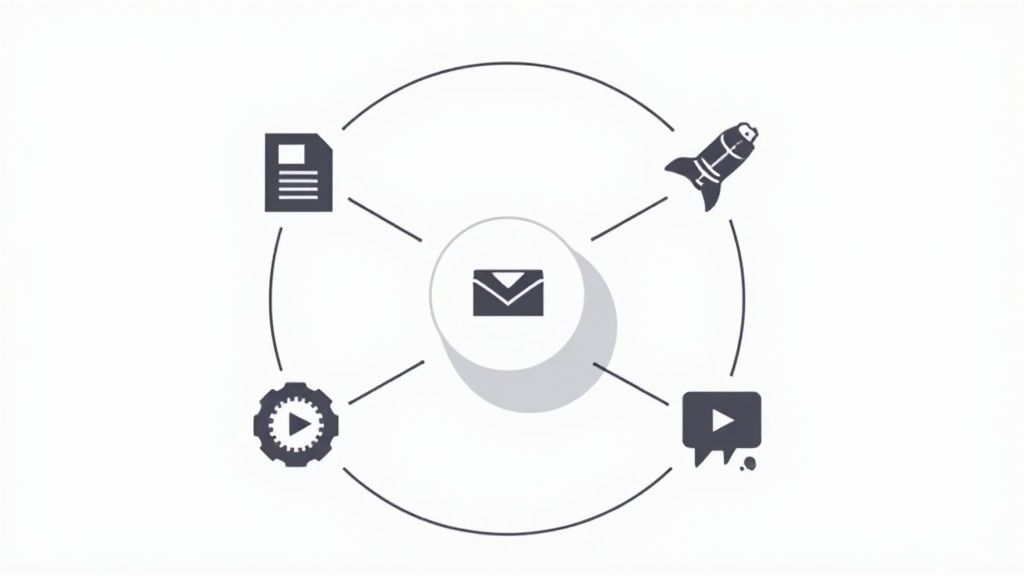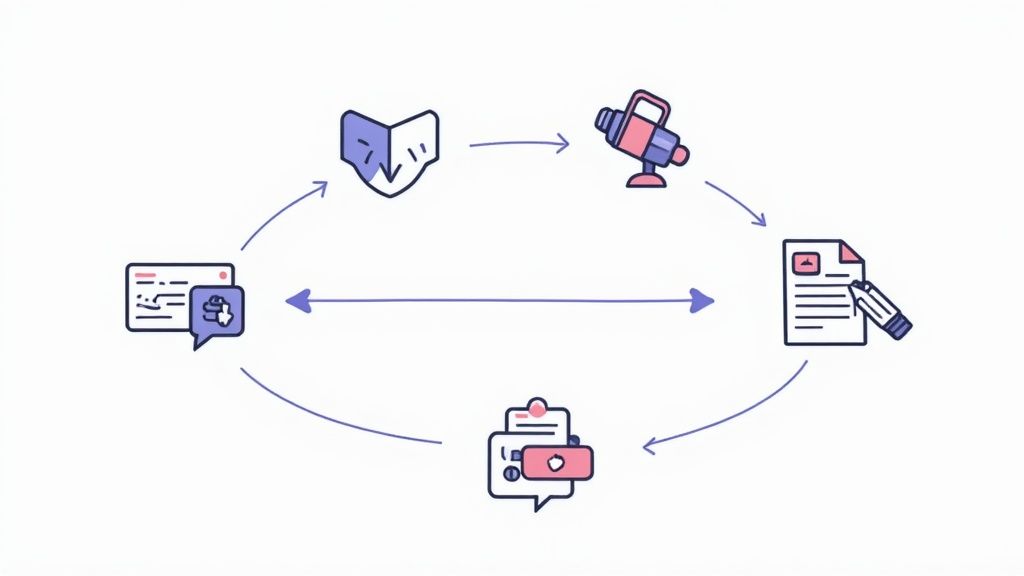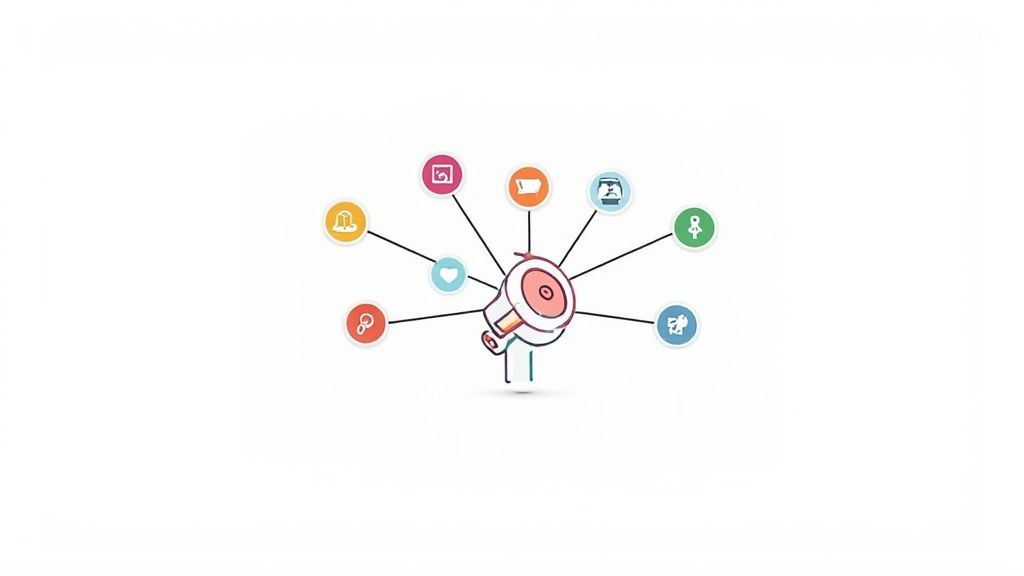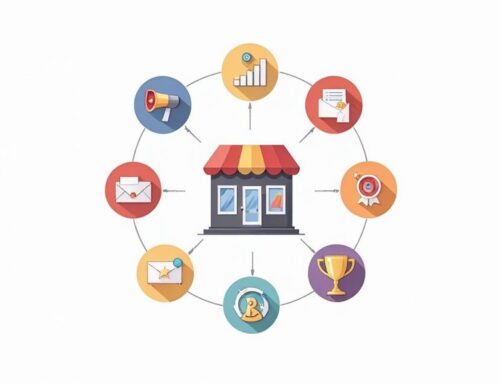Creating exceptional content is only half the battle. If you’re hitting ‘publish’ and hoping for the best, you’re leaving immense value on the table. The reality is that even the most brilliant blog post, video, or podcast will fail to make an impact without a deliberate and robust distribution plan. The internet is a crowded space, and simply owning a great piece of content doesn’t guarantee an audience. This is where strategic distribution comes in, the engine that propels your message from your dashboard to the screens of your target audience.
This isn’t just about sharing a link; it’s about systematically placing your content in front of the right people, in the right place, at the right time. Effective content distribution strategies are what turn a one-time asset into a long-term lead-generation machine.
In this guide, we will move beyond generic advice and dive deep into 10 potent content distribution strategies that separate viral hits from digital dust bunnies. Each strategy is a complete system with actionable steps, real-world examples, and a clear-eyed view of its pros and cons. Prepare to build a distribution machine that drives measurable results for your brand.
1. Strategy 1: Multi-Platform Syndication
Multi-platform syndication is one of the most powerful content distribution strategies available. Instead of publishing content on a single channel and hoping your audience finds it, this approach involves strategically distributing the same core piece of content across multiple platforms simultaneously. The goal is to meet diverse audience segments where they already are, maximizing reach, engagement, and brand visibility.
This method moves beyond simple cross-posting. It requires adapting the content’s format, tone, and presentation to suit the unique context and user expectations of each platform, from a professional article on LinkedIn to a quick visual tip on Instagram.

How to Implement This Strategy
Successfully executing multi-platform syndication involves a systematic process. The key is to create a core piece of “pillar” content, such as a detailed blog post or a long-form video, and then strategically repurpose it into various formats.
- Adapt and Repurpose: A single blog post can become a LinkedIn article, a Twitter thread, a series of Instagram graphics, and a discussion prompt on Facebook.
- Use Automation Wisely: Tools like Buffer or Hootsuite can schedule posts, but tailor the caption and format for each platform manually to ensure native performance.
- Track Performance Separately: Monitor analytics for each channel to understand what resonates. A topic that performs well on Medium might need a different angle to succeed on TikTok. For instance, marketing leader Neil Patel syndicates his comprehensive blog content to platforms like LinkedIn, modifying the introduction to directly address a business professional audience. This tailored approach ensures relevance and boosts engagement.
- Maintain a Calendar: A content distribution calendar is essential for mapping which assets go to which platforms and when, preventing audience fatigue and ensuring a consistent brand message.
2. Content Repurposing and Atomization
Content repurposing and atomization is a cornerstone of modern content distribution strategies. This approach focuses on maximizing the value of a single, substantial piece of content by breaking it down (atomizing) and transforming it into numerous smaller formats suitable for different channels. Instead of constantly creating new ideas from scratch, you amplify the reach of your best work, ensuring it connects with audiences across various platforms in the formats they prefer.
This strategy, popularized by marketing experts like Gary Vaynerchuk, treats every piece of “pillar” content, like a webinar or a detailed report, as a goldmine for derivative assets. It’s a highly efficient method for maintaining a consistent, high-volume presence without burning out your creative team.

How to Implement This Strategy
Effective atomization requires a systematic workflow to deconstruct and rebuild content. The goal is to extract key insights, quotes, and data points from a large asset and repackage them for maximum impact on each platform.
- Start with Cornerstone Content: Begin with a high-value, in-depth asset such as a podcast, a long-form article, or a research study. This will serve as the source material for all derivative pieces.
- Create a Repurposing Map: For each pillar piece, map out potential micro-content. For example, a single Joe Rogan podcast episode becomes multiple YouTube highlight clips, Instagram Reels, quote graphics, and Twitter discussion threads.
- Use Specialized Tools: Leverage tools to streamline the process. For example, use Lumen5 to quickly turn blog text into engaging videos or Canva to design visually appealing infographics and social media cards from key statistics.
- Maintain a Content Bank: Keep an organized library of all repurposed assets. This makes it easy to reschedule and reuse top-performing micro-content in future campaigns, extending its lifespan. Buffer’s team excels at this by transforming their blog posts into SlideShares, podcast episodes, and social media series, effectively reaching different audience learning styles. To learn more about specific techniques, explore these content repurposing strategies.
3. Influencer and Partnership Distribution
Tapping into established communities is one of the most effective content distribution strategies for rapid audience growth. Instead of building an audience from scratch, this approach involves leveraging relationships with influencers, industry partners, and complementary brands to share your content with their followers. This method instantly expands your reach and borrows the trust and credibility your partners have already built.
This strategy goes beyond a simple shout-out; it is a collaborative effort built on mutual value. It can range from an influencer sharing your blog post to a major SaaS company co-hosting a webinar, all designed to introduce your brand to a new, relevant audience.

How to Implement This Strategy
A successful partnership distribution plan requires careful selection, clear communication, and a focus on long-term relationships. The goal is to create authentic collaborations where both parties benefit.
- Identify Aligned Partners: Use tools like SparkToro or conduct manual research to find influencers and brands whose audience demographics and values match your own. An ideal partner is not just popular but relevant.
- Establish Clear Guidelines: Create a simple collaboration brief that outlines goals, expectations, key messages, and deliverables. This ensures everyone is aligned and prevents miscommunication.
- Provide Ready-to-Share Assets: Make it easy for partners to promote your content by providing them with pre-written social media posts, custom graphics, and tracked links. For example, Adobe often collaborates with design influencers by providing them early access to software and co-creating tutorial content that seamlessly integrates its products.
- Track and Measure Performance: Use UTM parameters for every link you provide to partners. This allows you to accurately measure the traffic, leads, and conversions generated from each collaboration, proving ROI and informing future partnerships. Explore how to build these relationships by learning more about influencer marketing on reachlabs.ai.
4. Email Newsletter Distribution
Email newsletter distribution remains one of the most effective and reliable content distribution strategies because it leverages an owned media channel. Instead of relying on third-party platform algorithms, this method involves building a direct line of communication with an audience that has explicitly opted in to receive your content. It provides unparalleled access to your most engaged followers.
This strategy centers on delivering high-value content, such as articles, case studies, or exclusive insights, directly to subscribers’ inboxes. The key is to nurture this relationship over time, building trust and establishing your brand as a go-to authority. Newsletters like Morning Brew and TheSkimm have scaled this model to millions of subscribers by mastering a consistent, value-first approach.

How to Implement This Strategy
A successful newsletter strategy requires more than just sending emails; it involves systematically growing and engaging your subscriber list. A great starting point is learning how to build an email list with targeted techniques and compelling lead magnets.
- Offer High-Value Lead Magnets: Create irresistible incentives like ebooks, checklists, or free templates to encourage sign-ups.
- Segment Your Audience: Group subscribers based on their interests, behaviors, or demographics to send highly relevant and personalized content.
- Maintain Consistency: Establish a predictable publishing schedule (daily, weekly, or monthly) so your audience knows when to expect your content. This builds habit and anticipation.
- Focus on Value, Not Just Sales: Prioritize delivering useful information, insights, and entertainment. Ben Thompson’s Stratechery is a prime example of a newsletter built entirely on high-quality analysis, making it indispensable for its audience.
- Optimize for Engagement: Continuously test different subject lines, send times, and content formats to see what resonates best with your subscribers and improves open rates.
5. SEO-Driven Content Distribution
SEO-driven content distribution is a fundamental strategy focused on making your content highly visible on search engines like Google. Instead of pushing content out to audiences, this method pulls them in by answering questions and solving problems they are actively searching for. It is one of the most sustainable content distribution strategies because it creates long-term organic traffic, establishing your brand as a trusted authority.
The core principle is to create content that aligns perfectly with user search intent, then optimize it to rank for relevant keywords. This turns your website into a powerful magnet for a high-intent audience, delivering continuous value long after the initial publication date.
How to Implement This Strategy
Effective SEO-driven distribution requires a proactive, research-first approach. It starts before you even write a single word and continues with ongoing optimization efforts.
- Conduct In-Depth Keyword Research: Use tools like Ahrefs or Semrush to identify what your target audience is searching for. Focus on keywords with a clear user intent that aligns with your expertise.
- Create Topic Clusters: Build your content around “pillar” pages that cover a broad topic, supported by “cluster” posts that dive into more specific sub-topics. For example, HubSpot’s marketing blog uses this model to dominate search results for countless marketing terms.
- Optimize for On-Page SEO: Ensure your content has optimized titles, meta descriptions, headers, and internal links. Structure articles for readability and target featured snippets by providing concise, direct answers to common questions.
- Build High-Quality Backlinks: Promote your content to relevant websites, journalists, and industry influencers to earn authoritative backlinks. Backlinko’s Brian Dean popularized the “Skyscraper Technique” for this very purpose.
- Update and Refresh Content: Regularly review your top-performing pages to ensure the information is current and accurate. This signals relevance to search engines and maintains high rankings.
6. Community-Based Distribution
Community-based distribution is a high-touch, value-driven approach where you share content within existing online communities where your target audience actively gathers. Instead of broadcasting a message, this strategy involves becoming a trusted member of groups on platforms like Reddit, Slack, Facebook Groups, or specialized forums. The goal is to provide genuine solutions and insights, establishing authority organically.
This method emphasizes contribution over promotion. It’s one of the most authentic content distribution strategies because it relies on building relationships and understanding the specific needs, culture, and rules of each unique community. When done correctly, your content becomes a welcome resource rather than an unwelcome advertisement.
How to Implement This Strategy
Effective community-based distribution requires patience and a genuine desire to help. The focus must always be on adding value to the conversation before you ever consider linking to your own content.
- Listen and Learn First: Spend time in a community before posting. Understand its rules, inside jokes, and what kind of content performs well. Identify the key contributors and moderators.
- Provide Value Consistently: Answer questions, offer advice, and participate in discussions without any self-promotion. Your initial goal is to build a reputation as a helpful expert.
- Share Content Contextually: Only share your content when it directly and thoroughly answers a question or adds significant value to a discussion. Frame it as a resource, not a sales pitch. For example, Buffer became a respected name by actively participating in marketing communities like GrowthHackers, sharing insights and resources that genuinely helped members.
- Engage with Feedback: When you do share content, stick around to answer questions and respond to comments. This reinforces your commitment to the community and provides valuable feedback for future content.
7. Paid Advertising Distribution
Paid advertising is one of the most direct and scalable content distribution strategies for reaching specific audiences with speed and precision. While organic methods rely on algorithms and audience discovery, this approach uses paid channels like social media ads, search engine marketing, and display networks to guarantee visibility. It allows you to place your content directly in front of highly targeted user segments.
The core principle is to pay for placement to overcome the limitations of organic reach and accelerate results. By defining your audience based on demographics, interests, and online behaviors, you can ensure your valuable content, whether a whitepaper or a video tutorial, connects with the people most likely to find it useful and convert.
How to Implement This Strategy
Effective paid distribution is a blend of creative excellence and analytical rigor. It requires a clear understanding of your audience and the platform’s capabilities to maximize return on investment.
- Start Small and Scale: Begin with a modest budget to test different ad creatives, targeting parameters, and content offers. Once you identify a winning combination, you can confidently scale your spending to amplify reach.
- Create Scroll-Stopping Creatives: Your ad’s visual and copy must capture attention instantly. Use compelling imagery, concise headlines, and a clear call to action that encourages users to engage with your content.
- Leverage Retargeting: Use retargeting campaigns to re-engage users who have previously interacted with your content or website. For example, LinkedIn Sponsored Content is highly effective for B2B marketers promoting case studies to professionals who visited their pricing page.
- Test and Optimize Continuously: Regularly monitor your campaign performance metrics, such as click-through rate (CTR) and cost per acquisition (CPA). A/B test different ad formats, placements, and audience segments to continually improve your ROI and drive down costs.
8. Employee Advocacy Programs
Employee advocacy programs are a highly effective method among modern content distribution strategies. This approach formalizes the process of empowering your employees to share company content on their personal and professional social networks. By leveraging the authentic voices and established credibility of your team members, you can significantly expand your content’s reach far beyond official brand channels.
This strategy transforms your employees into trusted brand ambassadors. Their shares are often perceived as more genuine and trustworthy than posts coming directly from a corporate account, leading to higher engagement rates. Companies like IBM and Salesforce have built powerful programs that amplify their messaging through the collective influence of their workforce.
How to Implement This Strategy
A successful employee advocacy program requires structure, support, and clear communication. The goal is to make it as easy and rewarding as possible for employees to participate, turning content sharing into a natural part of their professional routine.
- Provide Shareable Content: Use platforms like Hootsuite Amplify or GaggleAMP to create a centralized hub of pre-approved, ready-to-share content. This removes the guesswork for employees.
- Offer Clear Guidelines and Training: Equip your team with best practices for social sharing. Teach them how to add personal context to their posts to make them more authentic and engaging, rather than just reposting a link.
- Incentivize and Recognize Participation: Create a system of rewards to encourage consistent sharing. This could involve gamification with leaderboards, small prizes, or public recognition for top advocates. Adobe, for instance, highlights its employee advocates internally, fostering a culture of participation.
- Track and Measure Results: Monitor key metrics like reach, engagement, and website traffic generated through employee shares. This data helps demonstrate the program’s ROI and identifies your most influential advocates.
9. Content Syndication Networks
Leveraging content syndication networks is a paid content distribution strategy that places your articles on major publisher websites as recommended content. Unlike manual syndication, this method uses platforms like Outbrain or Taboola to automatically distribute your content across a vast network of partner sites, appearing in “recommended for you” widgets. This approach gives you immediate access to massive, established audiences you couldn’t otherwise reach.
The core principle is to get your content in front of readers who are already consuming similar topics on trusted news and media outlets. For instance, a fintech company could use a network to place its article on “Retirement Planning Tips” at the bottom of a related finance story on a major news site, driving highly relevant traffic.
How to Implement This Strategy
Successfully using content syndication networks requires careful campaign management and a clear understanding of your goals. It is a powerful tool for scaling content reach, but it demands strategic oversight to ensure a positive return on investment.
- Choose the Right Network: Research networks based on their publisher quality and audience demographics. General platforms like Taboola offer broad reach, while niche networks like TechTarget provide access to specific B2B technology professionals.
- Optimize for Clicks: Your headline and featured image are critical. They must be compelling enough to entice a click amidst a sea of other recommended articles. A/B test different combinations to find what works best.
- Set Clear Campaign Goals: Determine if your objective is brand awareness, lead generation, or website traffic. Set up your campaigns with appropriate bidding strategies and conversion tracking to measure success against these specific goals.
- Monitor Placements and Performance: Regularly review reports to see which publisher sites are driving the most valuable traffic. Most platforms allow you to block low-performing or irrelevant placements to optimize your ad spend and protect brand safety. This ensures your investment is focused on channels that deliver results.
10. Event and Webinar Distribution
Event and webinar distribution is an engaging and direct content distribution strategy that leverages live or virtual gatherings to share valuable information with a captive audience. Instead of passively publishing content, this approach creates an interactive experience, allowing for real-time engagement, questions, and feedback. It transforms content from a one-way broadcast into a two-way conversation.
This method is highly effective for delivering in-depth, high-value content, such as tutorials, product demos, industry insights, and thought leadership. By bringing people together for a specific purpose, you capture their undivided attention and build a stronger, more personal connection with your brand, positioning yourself as an authority in your field.
How to Implement This Strategy
A successful event-based distribution model hinges on providing genuine value and fostering interaction. The goal is to educate and engage, not just to present.
- Choose Relevant Platforms and Venues: Host virtual events on platforms like Zoom or GoToWebinar for accessibility. For in-person events, select venues that are convenient for your target audience and align with your brand’s image.
- Create Interactive and Engaging Content: Design your presentation with polls, Q&A sessions, and interactive elements to keep the audience involved. TED Talks are a prime example, using powerful storytelling to distribute complex ideas in a digestible format.
- Promote the Event Extensively: Use email marketing, social media, and partnerships to drive registrations. Build anticipation by sharing speaker information, session outlines, and sneak peeks of the content.
- Follow Up and Repurpose: After the event, send a follow-up email to all attendees with a recording, slides, and related resources. Edit the recording into smaller clips, blog posts, or social media content to extend its lifespan and reach. Salesforce’s Trailhead Live, for instance, offers live-streamed educational events that are later archived for on-demand viewing, maximizing content value.
Content Distribution Strategies Comparison
| Distribution Strategy | Implementation Complexity 🔄 | Resource Requirements ⚡ | Expected Outcomes 📊 | Ideal Use Cases 💡 | Key Advantages ⭐ |
|---|---|---|---|---|---|
| Multi-Platform Syndication | High – managing multiple platforms, optimizations | High – tools, team, content adaptation | Broad reach and brand visibility across channels | Brands targeting diverse audiences on multiple platforms | Massive reach, SEO benefits, consistent branding |
| Content Repurposing and Atomization | Medium-High – detailed content planning and format adaptation | Medium – creation and transformation effort | Extended content lifecycle, diversified formats | Maximizing ROI on cornerstone content, multi-format delivery | Higher ROI, varied audience engagement, efficient use of content |
| Influencer and Partnership Distribution | Medium – relationship and collaboration management | Medium – partner coordination and content support | Access to engaged, trusted audiences | Leveraging partners for credibility and expanded reach | Authentic engagement, cost-effective, credibility boost |
| Email Newsletter Distribution | Medium – list building, segmentation, content quality | Medium – content creation, platform use | High engagement, direct audience access | Nurturing loyal audiences, owned media communication | Highest ROI, full control, platform independence |
| SEO-Driven Content Distribution | High – requires technical SEO and ongoing updates | Medium-High – SEO expertise, content optimization | Sustainable long-term organic traffic | Targeting high-intent search audiences over time | Cost-effective long-term growth, authority building |
| Community-Based Distribution | Medium-High – requires active participation and relationship-building | Low-Medium – time investment, content tailoring | Deep engagement and viral potential | Engaging niche groups and forums with value-focused content | Highly engaged audiences, cost-effective, feedback-rich |
| Paid Advertising Distribution | Medium – campaign setup and continuous optimization | High – ongoing budget and ad management | Immediate reach with precise targeting | Time-sensitive campaigns, targeted audience segments | Fast results, detailed targeting, scalable control |
| Employee Advocacy Programs | Medium – employee training and content provision | Low-Medium – content assets and management | Authentic amplification and extended reach | Empowering internal teams to amplify brand content | Trusted sharing, increased reach, boosts employee engagement |
| Content Syndication Networks | Low-Medium – network setup and monitoring | Medium – subscription fees, monitoring tools | Automated scaling and industry-specific targeting | Amplifying content via third-party networks | Access to networks, automated scaling, niche targeting |
| Event and Webinar Distribution | High – event planning, technology, and engagement | High – time, resources, technology | Strong engagement and live interaction | Live expert positioning, interactive presentations | High attention, relationship building, repurposable content |
Activating Your Content: From Strategy to System
We’ve explored a comprehensive arsenal of content distribution strategies, from leveraging the immense reach of multi-platform syndication to the targeted precision of employee advocacy programs. Each method, whether it’s the creative power of content atomization or the authority-building potential of event-based distribution, offers a unique pathway to connect your message with the right audience at the right time.
However, the most profound takeaway is not the strength of any single tactic but the exponential power they wield when combined. True mastery lies in moving beyond a simple checklist and architecting a cohesive, integrated distribution system. The goal is to create a flywheel where different channels feed and amplify one another. Your SEO efforts can inform your email newsletter topics, which can then be repurposed into social media snippets and discussed in community forums, all driving traffic back to your core assets.
Building Your Distribution Engine
The journey from a list of tactics to a strategic framework can feel daunting, but it starts with a few deliberate steps. Don’t try to implement all ten strategies at once. Instead, adopt a phased, data-driven approach:
- Audit and Align: Begin by evaluating your existing resources, team capabilities, and, most importantly, where your target audience spends their time. Choose two or three strategies from this guide that offer the most direct alignment with your business goals and audience behavior. For a B2B SaaS company, this might be SEO, LinkedIn distribution, and webinar hosting. For a D2C e-commerce brand, it could be influencer partnerships, paid social ads, and community engagement on Instagram and TikTok.
- Execute and Measure: Dedicate your resources to mastering these initial channels. Establish clear Key Performance Indicators (KPIs) for each one. Is your goal to drive website traffic, generate leads, build brand awareness, or foster community engagement? Use analytics to track performance relentlessly, identifying what resonates and what doesn’t.
- Iterate and Expand: Based on your data, refine your approach. A/B test headlines for your email newsletters, experiment with different ad creatives, and analyze which repurposed content formats perform best. Once you have a well-oiled machine for your core strategies and are seeing consistent results, you can begin to layer in new channels, expanding your reach methodically.
Ultimately, effective content distribution strategies transform your content from a passive library of assets into an active, dynamic engine for business growth. This systematic approach ensures that every article, video, and report you create works as hard as possible to attract, engage, and convert your audience. By shifting your mindset from “publish” to “distribute,” you unlock the true ROI of your content creation efforts, building sustainable momentum that drives brand authority, customer loyalty, and measurable revenue.
Ready to automate and scale your content distribution with precision? ReachLabs.ai uses AI to identify the perfect influencers and podcasts for your brand, handling outreach and management to get your content in front of highly engaged audiences. Supercharge your content distribution strategies by visiting ReachLabs.ai to see how our platform can amplify your reach.





